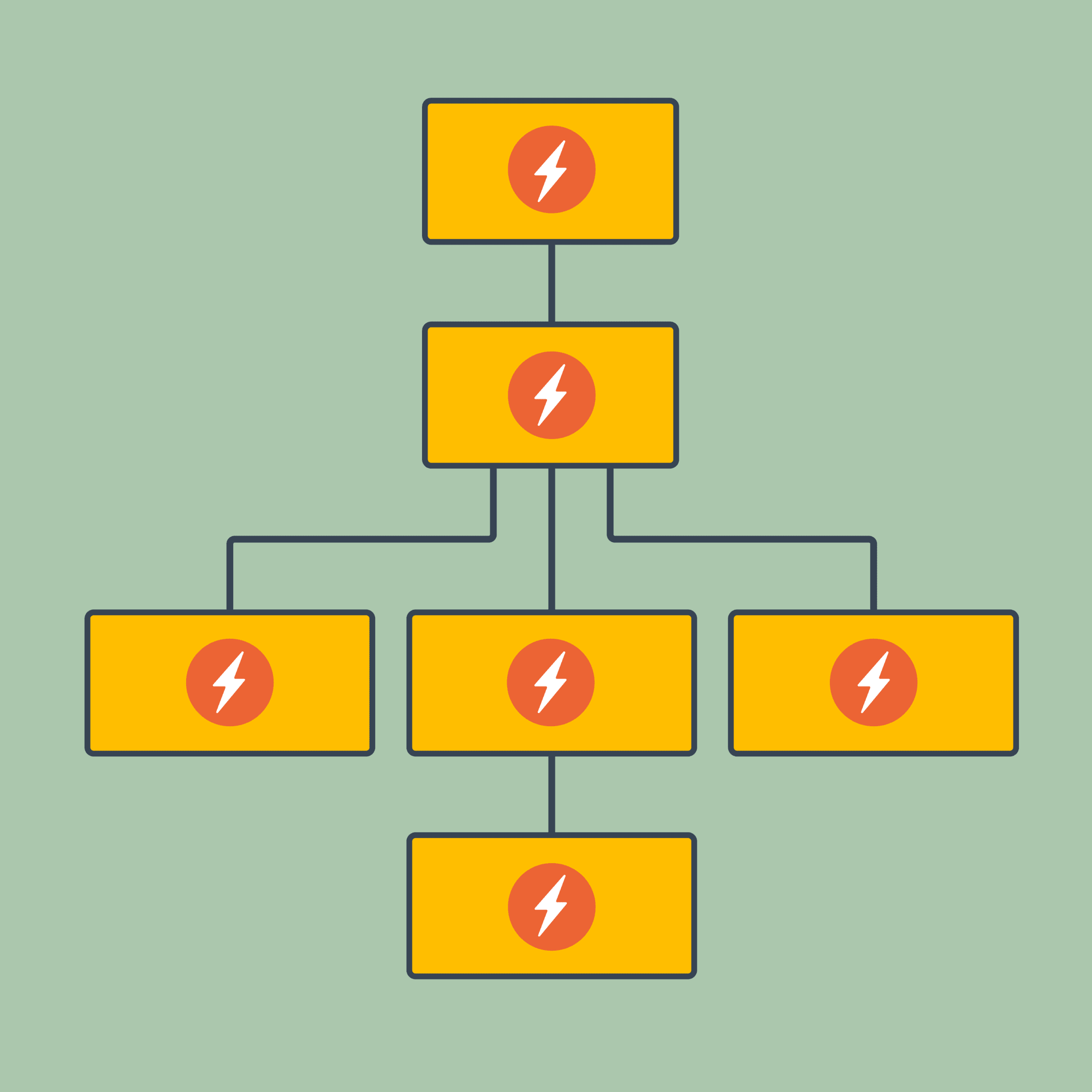
Simple Thread is a digital product agency with a focus in the electric power industry. The power and electric utility industry is absolutely fascinating in its scale and complexity and we love sharing all of the interesting things we have learned. The topics may vary from facts about the grid, to green energy, energy sustainability, basic electrical engineering, the future of the grid, and everything in between. If you’d like to hear more, keep checking back!
———————————————-
The United States power grid is quite possibly the most complex machine ever devised. As we discussed in the post A Tale of Two Grids the continental US power grid is actually made up of three separate synchronous grids called interconnections. These interconnections are:
- The Eastern Interconnection
- The Western Interconnection
- The Texas Interconnection
You can tell that clever names weren’t high on the todo list.
Federal Energy Regulatory Commission
These interconnections are massively complex, and managing, operating, and regulating them is a monumental task. At the top of the regulatory pyramid is FERC, the Federal Energy Regulatory Commission. FERC was formed in 1977 as a result of the Department of Energy Organization Act. The Department of Energy Organization Act abolished the previously created Federal Power Commission (FPC) and transferred its responsibilities to FERC.

FERC is the federal agency that regulates the transmission and sale of electricity across state lines. However its powers extend far beyond the electric grid to regulate other forms of energy such as natural gas and oil. It also has the responsibility of ensuring the reliability and security of the nation’s bulk power system. It does this in part through the oversight and approval of reliability standards for the U.S. bulk electric system (any part of the grid operating at 100kV or higher).
North American Electric Reliability Corporation
FERC doesn’t actually create these standards though, it does this through a partnership with an international nonprofit called the North American Electric Reliability Corporation (NERC). NERC is the successor to the North American Electric Reliability Council (Also NERC), which was a voluntary industry association formed in the aftermath of the Northeast Blackout of 1965.
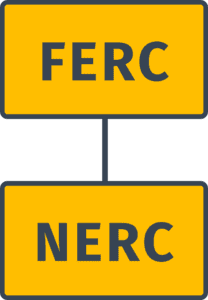
The current NERC was formed out of the Energy Policy Act of 2005 in the aftermath of the 2003 Northeast blackout. The Energy Policy Act of 2005 mandated the creation of an “Electric Reliability Organization” (ERO) within the United States in order to enforce reliability standards on the bulk power grid. In 2006 FERC approved the newly overhauled NERC to be the Electric Reliability Organization (ERO) for the United States.
NERC develops and oversees the enforcement of mandatory reliability standards across the United States, Canada, and parts of Mexico. It works with a variety of stakeholders including utility companies and other regulators to establish standards and best practices for operating the grid. It is also responsible for monitoring the grid’s performance, identifying risks, and performing audits to ensure compliance with its standards.
Regional Entities
You might have noticed that I said “oversees the enforcement of mandatory reliability standards” in the previous paragraph. Yes, NERC doesn’t actually enforce the standards, but instead delegates enforcement of their standards to six Regional Entities (REs).
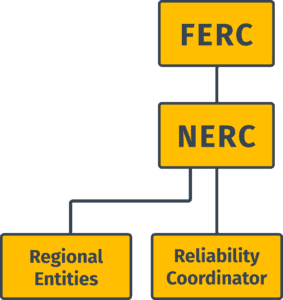
These Regional Entities are responsible for ensuring compliance with NERCs mandatory reliability standards within a specific region. They audit, assess, and investigate utilities and other electric grid participants for compliance with those reliability standards. They also work with NERC to develop additional regional reliability standards, if there are needs specific to where they operate.
Reliability Coordinators
Sitting alongside Regional Entities is another group of organizations known as Reliability Coordinators (RCs). Reliability Coordinators are certified by NERC and are the highest level organization responsible for the reliable functioning of the bulk electric system. RCs are primarily responsible for the real-time management of a specific area of the grid.

They have a wide-area and real-time view of the grid and they monitor things like grid conditions, generation output, and transmission line statuses. RCs ensure that generation and demand is balanced, and is also responsible for issuing reliability alerts or implementing emergency procedure directives. For example, they might tell a particular utility to reduce load on a particular transmission line in response to a situation on the grid.
Reliability Coordinators can be RTOs/ISOs (discussed below), other regional entities such as the Tennessee Valley Authority, or a single utility such as Southern Company.
Balancing Authorities
Balancing Authorities (BAs) are entities certified by NERC that are responsible for maintaining the balance between electricity supply and demand within a geographical area. There are currently 66 Balancing Authorities within the United States that range from large multi-state areas to small chunks of single states. BAs implement real-time grid operations such as dispatching generation, controlling electrical interchange with neighbors, and frequency regulation.
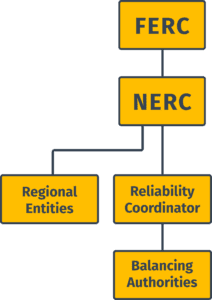
Balancing Authorities can be RTOs/ISOs (discussed below), other regional entities such as the Tennessee Valley Authority, or a single utility such as Southern Company.
RTOs and ISOs
As if all of this wasn’t complicated enough, there are also nine organizations known as either Regional Transmission Organizations (RTOs) or Independent System Operators (ISOs). These organizations are responsible for the operation, planning, and management of the transmission grid and electricity markets within their respective regions.
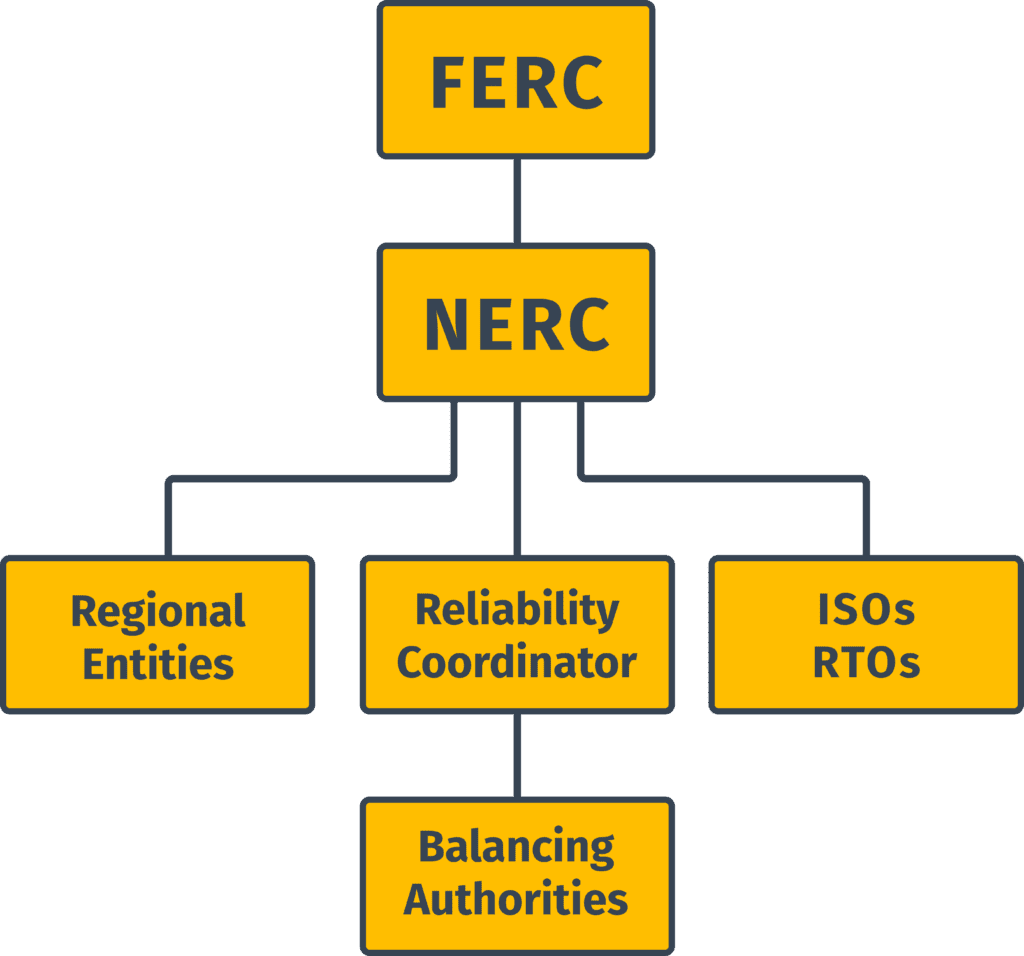
The main difference between ISOs and RTOs is that ISOs usually operate within a single state, while RTOs are larger regional entities. The naming is less than clear though, since both ISO New England (ISO-NE) and the Midcontinent ISO (MISO) are both RTOs. The reason for this is that ISOs were formed in 1996 as part of FERC Orders 888 and 889, while RTOs were not formed until FERC Order 2000 in 1999. MISO was made an ISO in 1998, but later also became the first RTO in 2001.
RTOs/ISOs and Regional Entities may seem redundant at first glance, but they serve very different purposes. Regional Entities are responsible for enforcing NERCs reliability standards, including enforcing those standards against RTOs and ISOs. RTOs and ISOs can be audited by Regional Entities and be penalized for non-compliance.
RTOs and ISOs have to implement those standards, but they are more concerned with coordinating, controlling, monitoring, and managing the grid and electricity markets within their region.
One other very important distinction is that RTOs and ISOs are voluntary, and not all of the United States is covered by either type of organization. Parts of the Southeast and Northwest are two of the largest regions that are not covered by ISOs or RTOs. Therefore utilities within those regions must form agreements with other power companies or ISOs/RTOs they want to interconnect with or to trade power with.
RTOs can also be ISOs, and they can also be Reliability Coordinators, Balancing Authorities, and Transmission Operators (see below)! For example, PJM is the RTO for most of the mid-Atlantic and serves as the Reliability Coordinator, Balancing Authority, and Transmission Operator within its footprint.
Transmission Operators
Next in the chain is the companies keep the electricity flowing smoothly in real time—the Transmission Operators (TOPs). Transmission Operators are responsible for the real-time operation, monitoring, and control of the transmission grid within their footprint. While Transmission Owners focus on maintaining and owning the physical infrastructure (see below), TOPs are the ones ensuring that electricity moves efficiently and reliably across the grid.
The responsibilities of a Transmission Operator are extensive, but their primary role is to manage real-time grid operations. They continuously monitor their piece of the grid, identifying and responding to any issues that arise, and work closely with Transmission Owners, Balancing Authorities, and regional entities to maintain system stability.
When it comes to real-time grid management, Transmission Operators are on the front lines, but rely heavily on Transmission Owners for the data they need to do their work. They are the ones who take immediate action when there’s a problem, coordinating the flow of electricity, adjusting generation as needed, and ensuring that power delivery remains uninterrupted.
Transmission Owners
And finally we get to the companies that do the work of actually maintaining the physical components of the grid! We call these Transmission Owners (TOs). Transmission Owners are responsible for the maintenance, monitoring, and operation of the part of the transmission grid they own. The list of responsibilities these organizations have is a mile long, but at the end of the day they own a piece of the transmission grid and are responsible for it.
There are organizations that sit around them that do things like enforce compliance and manage markets, but Transmission Owners are the folks that show up if there is an actual problem with the grid and fix it. They monitor their piece of the grid in real-time and communicate with transmission operators, balancing authorities, and regional entities to ensure that everything is running smoothly.
A Quick Example
This is all a bit complex, so to clarify things a bit, let’s look at an example. Simple Thread is headquartered in Richmond, Virginia on the east coast of the United States and so we are physically located within the eastern interconnection and the hierarchy of entities that oversees this area is this:
FERC – The federal agency that regulates the transmission and sale of electricity across state lines. Approves and oversees the creation of standards that are created and enforced by NERC.
NERC – The nonprofit organization responsible for establishing reliability standards for the North American power grid.
SERC – The SERC Reliability Corporation (which originally stood for Southeastern Electric Reliability Council) is the Regional Entity for all of the southeast that NERC has delegated authority to in order to enforce NERC reliability standards. Virginia is split between two Regional Entities: SERC and ReliabilityFirst.
PJM – PJM Interconnection Inc. is the RTO that Virginia is located within. The acronym originally stood for Pennsylvania-New Jersey-Maryland, but its footprint is much larger now. PJM oversees a part of the bulk electric system in parts of 13 states and Washington DC that has more than 185 gigawatts of generation capacity. It is also the regional Reliability Coordinator, Balancing Authority, and Transmission Operator for its region.
Dominion Energy – The power company which is the local Transmission Owner (TO), meaning that they actually build, maintain, and operate all of the local pieces of the bulk electric system that is overseen by PJM.
Summary
The management structure of the Bulk Power System in the United States is a complex system of organizations each with different responsibilities and authority. I hope that this article gives you a little better insight into the different organizations that exist and what they are responsible for.
Loved the article? Hated it? Didn’t even read it?
We’d love to hear from you.



